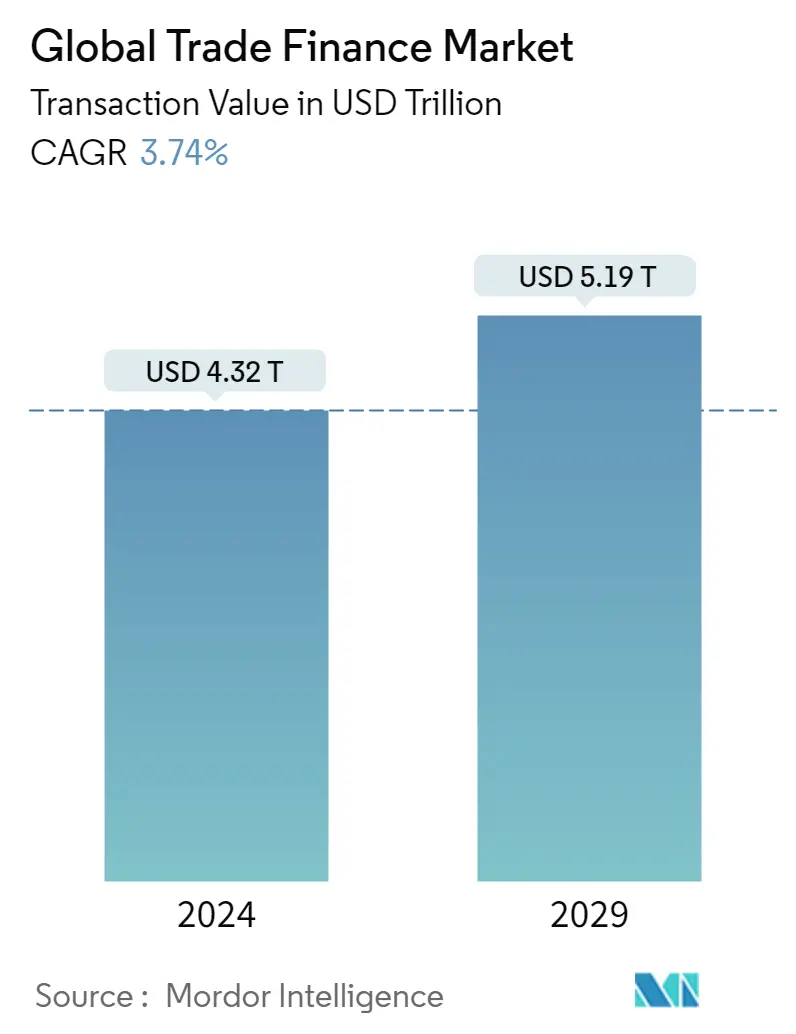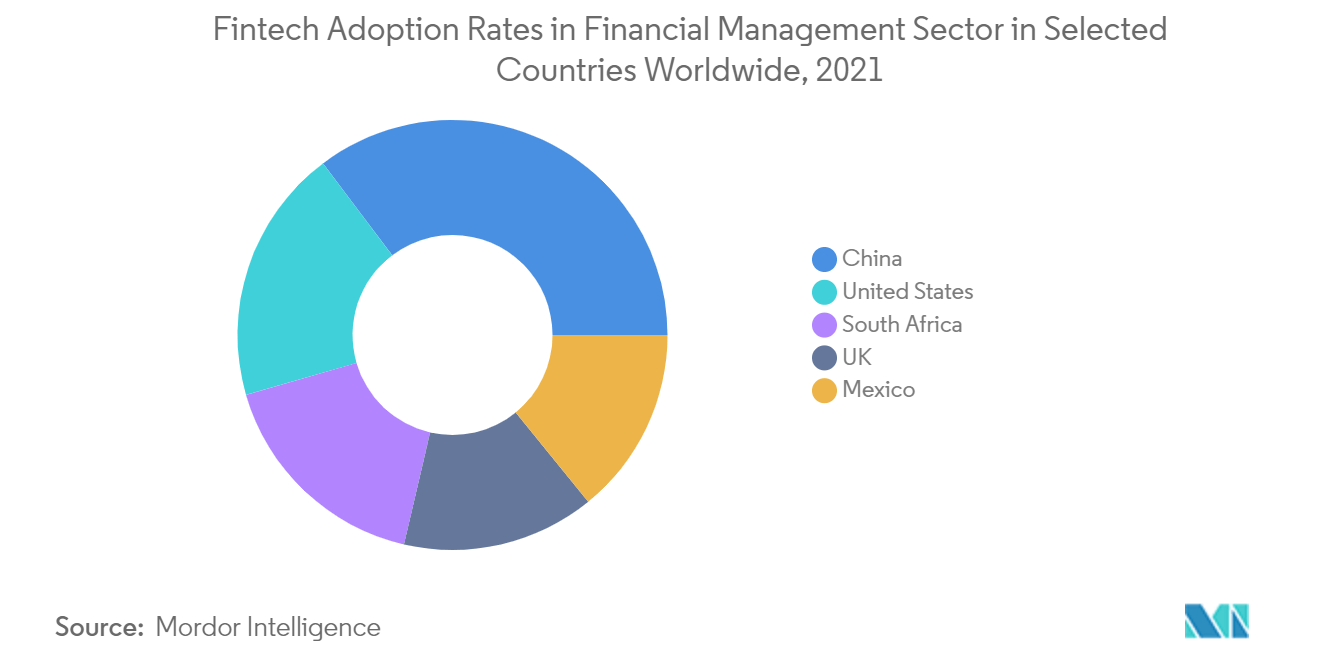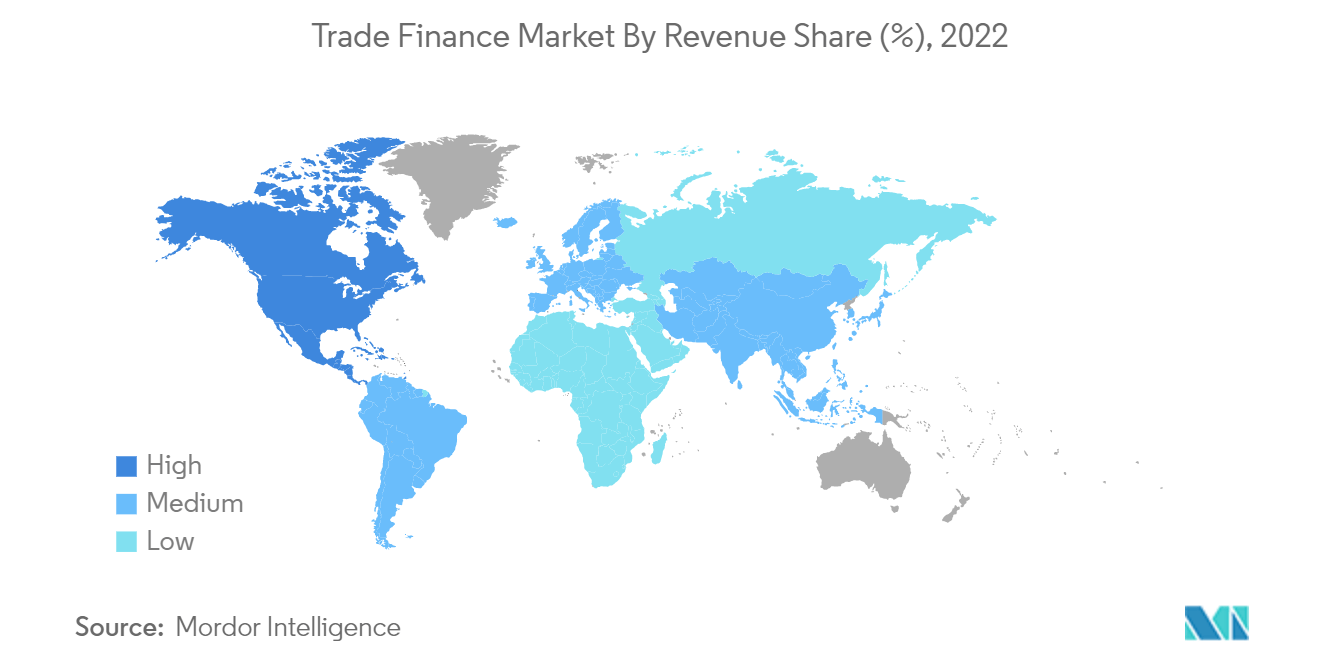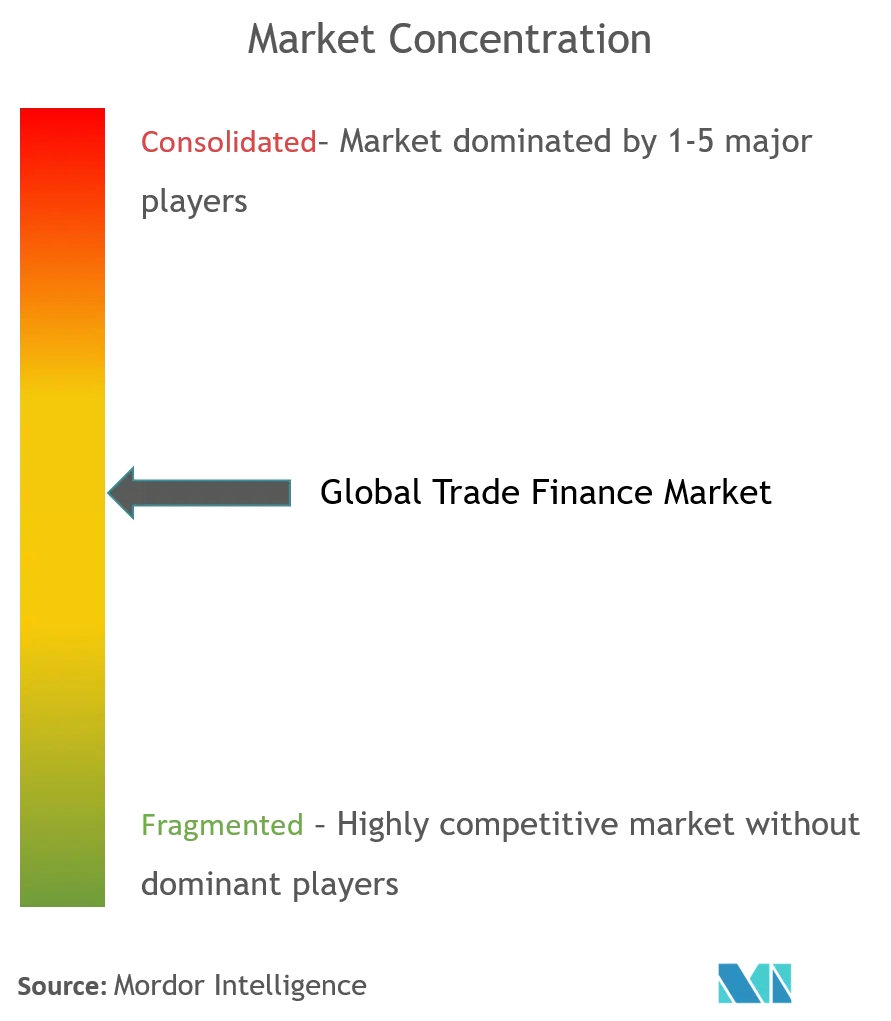Trade Finance Market Size

| Study Period | 2019 - 2028 |
| Market Size (2023) | USD 4.16 Trillion |
| Market Size (2028) | USD 5.00 Trillion |
| CAGR (2023 - 2028) | 3.74 % |
| Fastest Growing Market | Asia-Pacific |
| Largest Market | Asia-Pacific |
Major Players.webp)
*Disclaimer: Major Players sorted in no particular order |
Need a report that reflects how COVID-19 has impacted this market and its growth?
Trade Finance Market Analysis
The Global Trade Finance Market size in terms of transaction value is expected to grow from USD 4.16 trillion in 2023 to USD 5.00 trillion by 2028, at a CAGR of 3.74% during the forecast period (2023-2028).
Trade finance encompasses a variety of actions, such as lending, factoring, forfeiting, granting letters of credit, and export credit and financing. Several stakeholders are involved in the trade finance process, including the buyer and seller, the trade financier, export credit organizations, and insurers. Between 80% and 90% of global trade is supported by trade finance, which includes trade loans and guarantees. Less developed nations' exporters and importers frequently pay extremely high fees, which raises the cost of their trade, whereas wealthier nations' exporters and importers benefit from the low-interest rates and fees offered by international banks.
Furthermore, much of the factoring done in the trade finance industry is short-term in nature. However, trade finance does not always cover the same ground. Modern global trade has undergone structural changes as a result of the introduction of technology in trade finance. What were once closed systems are now adding new features to expand their services thanks to the adoption of open APIs.
The COVID-19 pandemic has strained health systems, disrupted trade, and sparked an unprecedented economic crisis. Faster vaccine distribution helped the global economy recover from 2021, but the recovery was uneven and characterized by problems with the supply chain and inflationary pressures. The availability of funding during the COVID-19 pandemic, when formal lending institutions would be too reluctant to lend, could come at a price so high that it would deter enterprises from borrowing, especially SMEs. According to the 2021 ADB Trade Finance Survey, 73% of banks did not cut down on capital availability or trade-supporting limitations, and 58% of banks did not cut back on financing for SMEs. However, as a result of the pandemic's increased macroeconomic uncertainty and banks' heightened sense of increased default risk, a higher percentage of SME application rejections, 40%, was experienced.
Trade Finance Market Trends
This section covers the major market trends shaping the Trade Finance Market according to our research experts:
Digitization Transformation is Driving the Market
Due to the impact of the coronavirus and changes in compliance requirements, the industry has transitioned from perceiving early adopters as driving the digital transformation to one where digitization is a must. The banks and funders must keep up with the groundswell of interest coming from the business end customer. Corporate treasurers are getting more and more frustrated with traditional working practices, and since their workforces are dispersed across numerous time zones and nations, digitization is becoming more and more crucial.
As their systems near their end of life, banks are searching for client-centric solutions to connect with their customers. Financial technology companies (fintech) are discovering that the justifications formerly given by banks and funders for not adopting a more digital or cloud-based manner of working are now justifications to do so. For instance, conducting our due diligence and KYC requirements is now more convenient and paperless when done digitally.
A rising number of people believe that the supply chain financing product technology should be the norm rather than its unique selling proposition, allowing collaboration and customer experience to set different financiers apart from one another in this market. As a result, banks and fintech ought to work together more as they support one another.

United States Dominates the Market in the North American Region
Modern technology is becoming more and more crucial to trade financing in the United States. The adoption of blockchain technology in trade finance is anticipated to create lucrative business prospects during the anticipated time period. The demand for safety and security in trading activities is fueling the expansion of the trade finance industry in the United States, along with a surge in SMEs' use of trade financing, more intense competition, and new trade agreements. American multinational corporations have started implementing digital technologies that promise improved supply-chain transparency and efficiency, as well as developing new digital networks to facilitate commerce and financing. The nation's overall international trade imports and exports are increasing in value, which is what's causing the trade finance market to grow.

Trade Finance Industry Overview
The research provides a general overview of the trade financing market's competition and a fast recap of recent merger and acquisition deals. It comprises corporate profiles of a few trade finance and trade technology companies in the industry, in addition to banks. Some of the top companies now dominating the market include Santandar, Standard Chartered Bank, and Scotia Bank.
Trade Finance Market Leaders
Santander Bank
ScotiaBank
Commerzbank
Nordea Group
Standard Chartered Bank
*Disclaimer: Major Players sorted in no particular order

Trade Finance Market News
- Dec 2022: In collaboration with Majid Al Futtain Retail, the area's Carrefour franchisee, Standard Chartered unveiled what it claims is the Middle East's first sustainable supply chain finance initiative.
- Dec 2022: "Quantum-secure" digital trade finance instruments will be released by Traxpay and Arqit.
- Dec 2022: Kyriba introduced a receivables financing solution to assist businesses in releasing constrained funds.
Trade Finance Market Report - Table of Contents
1. INTRODUCTION
1.1 Study Assumptions and Market Definition
1.2 Scope of the Study
2. RESEARCH METHODOLOGY
3. EXECUTIVE SUMMARY
4. MARKET INSIGHTS AND DYNAMICS
4.1 Market Overview
4.1.1 World's Top Exporters And Importers - Their Trade Finance Usage
4.1.2 Importance of Trade Financing Types
4.2 Tradetech - Technology Adoption By the Market
4.2.1 Bank Consortium For Adopting Block Chain And Distributed ledger Technologies (DLT)
4.2.2 Use Cases of Technology in The Trade Finance Processes (Supply Chain Finance Platforms, Asset Distribution Platforms, IT Systems, etc)
4.3 Regulatory Landscape Governing The Eco-system
4.3.1 Trends in Trade Finance regulation
4.3.2 Regulations To Deal With Money Laundering, Terrorist Financing, and Sanctions
4.4 Insights on International Trade Finance Gap
4.5 Market Drivers
4.6 Market Restraints
4.7 Value Chain / Supply Chain Analysis
4.8 Porter's Five Forces Analysis
4.8.1 Threat of New Entrants
4.8.2 Bargaining Power of Buyers/Consumers
4.8.3 Bargaining Power of Suppliers
4.8.4 Threat of Substitute Products
4.8.5 Intensity of Competitive Rivalry
4.9 Impact of COVID-19 on the Market
5. MARKET SEGMENTATION
5.1 Geography
5.1.1 North America
5.1.1.1 US
5.1.1.2 Canada
5.1.1.3 Mexico
5.1.1.4 Rest of North America
5.1.2 Europe
5.1.2.1 Germany
5.1.2.2 UK
5.1.2.3 France
5.1.2.4 Russia
5.1.2.5 Spain
5.1.2.6 Rest of Europe
5.1.3 Asia-Pacific
5.1.3.1 India
5.1.3.2 China
5.1.3.3 Japan
5.1.3.4 Rest of Asia-Pacific
5.1.4 South America
5.1.4.1 Brazil
5.1.4.2 Argentina
5.1.5 Middle East
5.1.5.1 UAE
5.1.5.2 Saudi Arabia
5.1.5.3 Rest of Middle East
5.2 By Service Provider
5.2.1 Banks
5.2.2 Trade Finance Companies
5.2.3 Insurance Companies
5.2.4 Other Service Providers
6. COMPETITIVE LANDSCAPE
6.1 Market Competition Overview (Market Concentration And M&A Deals)
6.2 Company Profiles
6.2.1 Citi group Inc.
6.2.2 Santander Bank
6.2.3 Scotiabank
6.2.4 Commerzbank
6.2.5 Nordea Group
6.2.6 Unicredit
6.2.7 Standard Chartered Bank
6.2.8 Arab Bank
6.2.9 Societe Generale
6.2.10 Rand Merchant Bank
6.2.11 Rabobank
6.2.12 China Construction Bank
6.2.13 BNP Paribas*
- *List Not Exhaustive
7. MARKET OPPORTUNITIES AND FUTURE TRENDS
Trade Finance Industry Segmentation
The financial tools and goods used by businesses to support international trade and commerce are referred to as trade finance. Commerce financing makes it simpler for importers and exporters to conduct business through trade. The Trade Finance Market is fragmented and is segmented based on Service Provider (Banks, Trade Finance Companies, Insurance Companies, and Other Service Providers) and Geography (North America, Europe, the Middle East, South America, and Asia-Pacific). The report offers market size and values in (USD billion) during the forecast years for the above segments.
| Geography | ||||||||
| ||||||||
| ||||||||
| ||||||||
| ||||||||
|
| By Service Provider | |
| Banks | |
| Trade Finance Companies | |
| Insurance Companies | |
| Other Service Providers |
Trade Finance Market Research FAQs
How big is the Global Trade Finance Market?
The Global Trade Finance Market size is expected to reach USD 4.16 trillion in 2023 and grow at a CAGR of 3.74% to reach USD 5.00 trillion by 2028.
What is the current Global Trade Finance Market size?
In 2023, the Global Trade Finance Market size is expected to reach USD 4.16 trillion.
Who are the key players in Global Trade Finance Market?
Santander Bank, ScotiaBank, Commerzbank, Nordea Group and Standard Chartered Bank are the major companies operating in the Global Trade Finance Market.
Which is the fastest growing region in Global Trade Finance Market?
Asia-Pacific is estimated to grow at the highest CAGR over the forecast period (2023-2028).
Which region has the biggest share in Global Trade Finance Market?
In 2023, the Asia-Pacific accounts for the largest market share in the Global Trade Finance Market.
Trade Finance Industry Report
Statistics for the 2023 Trade Finance market share, size and revenue growth rate, created by Mordor Intelligence™ Industry Reports. Trade Finance analysis includes a market forecast outlook to 2028 and historical overview. Get a sample of this industry analysis as a free report PDF download.
